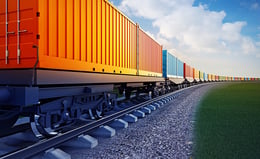Signs That It Might Be Time to Evaluate Your TMS
Martin Pahulje - August 31, 2021

Each year, supply chains grow increasingly complex, and the state-of-the-art transportation management system (TMS) of last year may be outdated today. To maximize your fleet’s productivity and efficiency, it is critical that you utilize the best possible TMS, whether you run one truck or thousands. But, all TMSs are different, and it can be challenging to determine if your current TMS is performing as well as it should be. You may even be unaware that your TMS is underperforming compared to its potential. If this is the case, you need to evaluate the status of your current TMS and determine if an upgrade is necessary. To make this decision, review these five signs to indicate if it is time for a new TMS.
1. Upscaling Operations
As the economy begins to bounce back, consumer demand has increased rapidly. In response, supply chains are rapidly scaling up their operations to satisfy customer needs. In addition to more orders being placed,  there is an increased demand for fast delivery, which means additional vehicles are needed. Whether this is a minor or significant upscale, any increase in your fleet will result in more administrative and logistical work. If you are not currently utilizing TMS software, upscaling your fleet is a clear sign that you need one.
there is an increased demand for fast delivery, which means additional vehicles are needed. Whether this is a minor or significant upscale, any increase in your fleet will result in more administrative and logistical work. If you are not currently utilizing TMS software, upscaling your fleet is a clear sign that you need one.
The right TMS software will enable you to keep costs and services competitive while adapting to your changing needs. This will allow you to streamline operational processes, reducing the challenges that come with upscaling. Additionally, a TMS will simplify any future upscales, ensuring that you can adjust operations as consumer demands fluctuate.
2. Increasingly Complex Needs
Technology has drastically changed how supply chains operate, and each year supply chains grow more complex as the industry adopts new technologies. In addition to supply chains, the trucking industry has grown more complex as well. As our technological capabilities increase, so do customer expectations. Today, customers expect to receive their orders quickly, and they want insight into the status of their order from beginning to end. To manage these expectations, you must have a TMS that can keep up.
Your supply chain has likely grown since you first adopted your TMS, so your current system may no longer be adequate to support your growing dispatch process. To keep up with industry developments and evolving supply chains, adopting a modern TMS is critical.
3. Current System is Outdated
It can be challenging to determine if your current TMS is outdated, but a typical sign is that it simply cannot keep up with your operations. You may be experiencing problems that you don't even realize are due to an outdated TMS. If this is the case, considering if you are experiencing these problems:
- Difficulty making data-driven decisions.
- Limited scalability.
- Increased time waste.
- Failure to send invoices promptly.
- Cash flow problems.
- Inability to monitor or track freight.
- Difficult in managing carrier and vendor relations.
If you are experiencing any of these issues, it’s likely that your TMS isn’t performing as well as it should. The right TMS should be able to be accessed from anywhere, including remote access on tablets and smartphones, to guarantee fast response. Your TMS software should also be able to combine significant amounts of information to provide custom reports for specific needs and challenges. It should also be compatible with your existing IT infrastructure to ensure that data is accurate and shared efficiently. Finally, a TMS must be flexible and scalable. Choosing a TMS that can scale up to fluctuating demand is critical in saving significant investments and IT capacity. Even so, the right TMS may still face technical challenges, so you should also ensure your provider offers quality support on time to help you resolve disruptions quickly.
4. Looking to Cut IT Costs
There is no question that IT is essential to companies in the supply chain industry. For companies to stay competitive today, they must digitize their supply chains. This requires a highly capable IT infrastructure and a team of experts, which are not inexpensive to come by. As a result, many organizations are looking to cut their IT costs while maintaining the technology that enables them to operate efficiently. Fortunately, the right TMS can help you do so.
An integrated cloud-based TMS will not only improve freight operations but can also reduce your IT costs significantly. Because the right TMS will be compatible with preexisting software, you can ensure that the systems working together are doing so efficiently, maximizing the value of your current IT. An optimized TMS serves as a cost-effective alternative to traditional on-premise software, minimizing costs while maximizing value.
5. Need to Improve Driver Retention
If you are working in the supply chain or trucking industry, you are more than likely aware of the current driver shortage we are experiencing. Following the pandemic outbreak, supply chains worldwide began facing shortages, and a significant one is truck drivers. This has been highly problematic for shippers, causing delivery delays and tremendous costs. As a result, many companies are looking to improve driver retention to ensure the timely delivery of their products.
Before you can improve driver retention, you must evaluate your current administrative and operating processes. Ask yourself these questions:
- Are drivers being paid accurately and on time?
- Are you making the best use of driver hours by maximizing shipments and avoiding delays?
- Do your drivers have adequate equipment?
- Do you have a strong relationship and communication with your drivers?
Ensuring that you can answer “yes” to these questions is the first step to improving driver retention. Fortunately, a TMS can help you achieve this. The right TMS can offer contactless signatures, properly matched loads, optimized driving routes, and more. These capabilities will ensure that your drivers experience a satisfactory work environment. The more satisfied your drivers are, the longer they will choose to stay with your organization, and you will likely attract new drivers as well. Additionally, more satisfied employees often translate to better performance, improving the experience for your customers as well. Furthermore, this will optimize supply chain operations while increasing your bottom line.
It can be challenging to find the right TMS, especially if you don't know what you're missing. By evaluating your current TMS, you can identify needs that are not being satisfied. With this information, it's time to find a new and optimized TMS that ensures you are operating with the utmost efficiency. As you find a new provider, consider integration capabilities, cloud-enabled solutions, and upgrades and support in addition to its basic functions. Remember, your TMS should make trucking easier, not harder – utilize these signs to find a TMS that optimizes the trucking process, both in the office and on the road.
Click below to download our guide on The Leaner Greener Challenge.
LATEST POSTS
- Understand Circular Economy in The Manufacturing Industry
- How Can Industry 4.0 IT Integration Be Achieved Smoothly?
- The Significance of Order Sequencing in Discrete Manufacturing
- How to improve your Supply Chain Management: The Power of Control Towers
- Optimizing Human Resource Scheduling in Manufacturing: A Technological Approach



